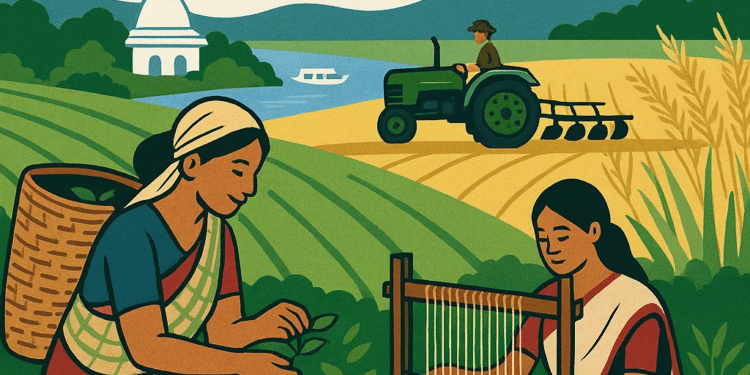GUWAHATI: Assam’s economy is brewing a new chapter. From the sprawling tea estates of Upper Assam to the silk looms of Sualkuchi and the orchards of Sonitpur, almost every household in the state is set to feel the impact of the 2025 GST reforms. By slashing tax rates to 5% across key sectors, the reforms promise cheaper prices for consumers, higher competitiveness of industries, and more secure livelihoods for millions.
Tea: Brewing change in a centuries-old industry
Tea is Assam’s pride, its largest employer, and one of India’s most recognized exports. Nearly 6.84 lakh workers depend directly on its estates and small gardens, with entire families tied to the rhythms of plucking, sorting, and processing.
Under the new GST regime, tea has been placed in the 5% slab, reducing shelf prices by an estimated 11%. For Indian consumers, this makes their daily cup more affordable. For exporters, it sharpens the state’s competitive edge. India exported 255 million kilograms of tea in 2024, and officials expect Assam’s share to grow as international buyers respond to lower prices.
The domestic market, centered around the Guwahati Tea Auction Centre, also stands to gain. Cheaper tea encourages higher volumes, raising estate revenues and creating scope for better wages. For small growers producing orthodox and specialty teas, the reforms bring relief in more ways than one: fertilizers and other inputs are cheaper, while their products — often sold to niche global buyers — become more attractive in price-sensitive markets.
“Tea is more than a commodity here; it is a way of life,” said a Guwahati-based exporter. “These reforms strengthen both the industry and the workers who sustain it.”
Handlooms and crafts: Weaving opportunity
If tea represents Assam’s economic backbone, handloom is its cultural heartbeat. The state has more than 12.83 lakh weavers and 12.46 lakh looms, many of them women working from rural households. Together, they keep alive the traditions of muga silk, mekhela-sador and the gamosa — textiles that carry the identity of Assam across the country and abroad.
Placing handlooms and handicrafts in the 5% GST bracket means prices for most products will fall by about 6.25%. That reduction is small but significant. It makes Assamese fabrics and crafts more competitive without forcing weavers to cut into already thin margins.
The muga silk industry, which supplies 95% of India’s golden silk, could particularly benefit. Its sarees, stoles and accessories, often bought by luxury buyers, may now find new traction in both domestic and export markets. Everyday textiles, such as gamosa, are likely to see stronger demand from institutional buyers and the Assamese diaspora.
In Sualkuchi, known as the Manchester of the East, a weaver described the change as empowering. “This makes our handloom products more affordable without eating into our margins,” she said. “It helps us compete with factory-made cloth.”
Beyond textiles, craft traditions such as the Assam Jaapi, Asharikandi terracotta, Mishing handloom products and the Bihu dhol are also covered, giving a boost to artisans in Goalpara, Majuli and Nalbari.
Tourism and hospitality: Affordable Assam
Tourism is another sector expected to feel the ripple of reform. Assam’s natural and cultural wealth — from the rhinos of Kaziranga to the monasteries of Majuli and the birdlife of Pobitora — already draws visitors from India and abroad. The sector supports more than 6.51 lakh jobs, spread across hotels, homestays, tour operators, boatmen and guides.
Now, hotel rooms priced up to ₹7,500 per night fall under the 5% GST bracket. For domestic travelers, that makes Assam’s mid-range accommodations far more affordable. Essentials such as toiletries, packaged water and restaurant meals are also taxed at 5%, further cutting costs.
The net effect, industry insiders say, will be higher footfall and longer stays. More visitors mean more income across the chain — from city-based hoteliers in Guwahati to homestay operators run by women in Majuli.
Agriculture and horticulture: GI crops shine
The reforms also reach deep into Assam’s farmlands. Several of the state’s Geographical Indication (GI) crops are now taxed at 5% in their processed forms, encouraging farmers to diversify into value-added products.
Joha rice, grown across Goalpara, Nalbari, Barpeta and Kamrup, will see ready-to-cook mixes and flours sold at lower prices. Boka Saul, or magic rice, beloved during festivals and floods for its quick-soak cooking, becomes more affordable in packaged form. Kaji Nemu, Assam’s distinct lemon, will see juices and pickles taxed at just 5%, making them cheaper by up to 11% for consumers while boosting export prospects. Tezpur litchi pulp and jams also join the list, easing consumer prices by about 6.25% while improving margins for orchard growers and seasonal workers.
These reductions may appear modest, but for small-plot farmers they mean higher volumes and steadier incomes. In recent years, exports of Kaji Nemu and Tezpur litchi to the UK have signaled global potential. Lower GST could help such shipments grow.
A ripple effect across households
Economists point out that the GST reforms are unusual in their reach. Few policy changes touch so many different kinds of livelihoods at once — tea pluckers, weavers, orchard workers, hotel staff and craft artisans.
“This is a tax shift with very human consequences,” said a researcher at Gauhati University. “It touches the farmer, the weaver, the tea plucker and the hotel worker, all at once. It also gives traditional industries a better chance in modern markets.”
A bridge between tradition and opportunity
For Assam, the 2025 GST reforms are more than fiscal adjustments. They are a bridge between tradition and opportunity — a way of sustaining cultural industries while opening new economic doors.
By making everyday products cheaper and exports more competitive, the reforms are expected to spark demand, generate employment and reinforce the state’s place in India’s growth story. From tea cups in Baghdad and London to handloom stoles sold in Delhi and New York, Assam’s economy is poised to stretch its reach further.
And in homes across the state, from tea estates to loom villages, the benefits could translate into something simpler: steadier orders, higher incomes and greater dignity in work.
DATA: PIB

















